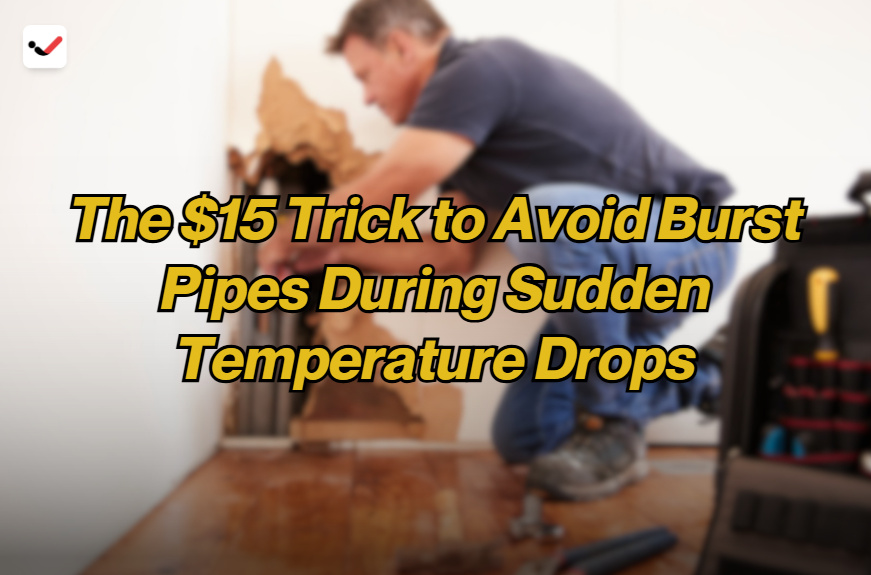The $15 Trick to Avoid Burst Pipes During Sudden Temperature Drops
The $15 Trick to Avoid Burst Pipes During Sudden Temperature Drops

When the temperature drops suddenly, one of the biggest threats to your home is burst pipes. A frozen pipe can crack and flood your house, causing thousands of dollars in water damage. This usually happens when water inside the pipe freezes and expands, putting pressure on the pipe walls until they break. Repairing burst pipes can be expensive and stressful—and often avoidable.
Good news: there’s a simple $15 trick that can save you from this winter disaster. It doesn’t require a plumber or expensive tools. Just a bit of planning and a very affordable product you can buy at any hardware store. If you want to prevent frozen pipes and protect your home during cold snaps, this trick is a game changer.
Why Pipes Burst During Freezing Weather
Pipes burst in cold weather because water expands when it freezes. If the water inside your pipes turns to ice, it puts a lot of pressure on the pipe walls. This pressure builds up until the pipe cracks or breaks. It happens more often in unheated areas like basements, attics, garages, and even under kitchen or bathroom sinks.
The damage from a burst pipe can be huge. In just a few hours, your home could be flooded with gallons of water. Floors, walls, and furniture can be ruined. Insurance might cover some of it, but the cleanup and stress are never worth it. That’s why homeowners should take winter pipe protection seriously.
The $15 Trick: Pipe Insulation Foam
The best cheap solution to avoid frozen pipes is pipe insulation foam. These are long, tube-shaped sleeves made of foam that you can slip over your pipes. They cost about $1 to $3 per six-foot length, and you can find them at Home Depot, Lowe’s, or even on Amazon. For $15, you can protect a good portion of your home’s vulnerable pipes.
Pipe insulation works by keeping the cold air away from the pipe surface. It helps maintain a more stable temperature, slowing down how fast the pipe gets cold. It won’t make the pipe warm, but it reduces the risk of freezing, especially during short cold snaps or overnight temperature drops.
Where to Install Pipe Insulation
To get the most out of this trick, install foam pipe insulation in the right places:
Basements and crawl spaces: These are common places where pipes run and where the air gets very cold.
Under sinks: Especially if the sinks are against an outside wall.
Garages and utility rooms: Pipes running through these unheated areas are at high risk.
Exposed outdoor pipes: Even though outdoor pipes should be drained before winter, insulation can add extra protection.
You don’t need special tools. Most foam insulation tubes are pre-slit and self-sealing. You just open the slit, wrap it around the pipe, and press it shut. For extra protection, you can tape the seams with weatherproof tape.
Bonus Tips to Prevent Frozen Pipes
Pipe insulation is your first defense, but it works even better when combined with these simple tricks:
Let faucets drip: A slow trickle keeps water moving, which makes freezing less likely.
Open cabinet doors: This lets warmer air circulate around pipes under sinks.
Keep garage doors closed: Especially if water supply lines run through the garage.
Seal cracks and gaps: Use caulk or spray foam to seal holes near pipes where cold air can enter.
Even with pipe insulation, extreme cold can still freeze your pipes if your home is poorly insulated. So these extra steps help create a backup line of defense.
What Happens If a Pipe Freezes?
If a pipe freezes, act fast to prevent it from bursting:
Turn off the main water supply.
Open the faucet connected to the frozen pipe to relieve pressure.
Use a hair dryer, heating pad, or space heater to warm the pipe. Never use an open flame.
If the pipe has already burst, you’ll need to shut off the water and call a plumber. Water damage can spread quickly, so the sooner you stop the flow, the better.
Why Prevention is Cheaper
The average cost to fix a burst pipe is between $500 and $1,500. If there’s water damage, that cost jumps into the thousands. Pipe insulation, on the other hand, costs about $15 for a basic setup. That’s a tiny price to pay for peace of mind during cold weather.
Preventing frozen pipes also saves you time and keeps your household running smoothly. No one wants to be without water or face a plumbing emergency in the middle of winter. Preventative measures like this are not only cheap—they’re smart.
Ideal Time to Insulate Pipes
Don’t wait until the forecast shows a freeze. Install pipe insulation in early fall or even late summer. It’s a one-time job that takes just an hour or two and doesn’t need to be repeated every year unless the insulation wears out.
If you're a landlord or property manager, protecting pipes in your rental properties is just as important. Frozen pipes can ruin your tenants’ belongings and leave you with a huge repair bill. A quick $15 fix can help avoid legal and financial headaches.
Avoiding burst pipes in winter doesn’t have to be complicated or costly. A $15 investment in pipe insulation foam, combined with a few smart habits, can save your home from water damage and save you from expensive repairs. It’s a simple, low-cost way to protect your home during sudden temperature drops.
Don’t wait for the first freeze warning to take action. Get the supplies, install the insulation, and give your pipes a fighting chance. Winter comes fast—be ready.

